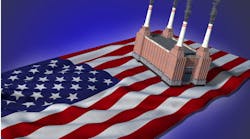Two measures commonly used by the government to measure manufacturing’s overall impact on society are badly underestimating the impact of that critical sector. One is the proportion of gross domestic product for which manufacturing accounts. The other is the “multiplier effect,” which measures the impact on other industries from an increase in economic activity by a specific industry.
Official national statistics state that manufacturing’s proportion of GDP—its annual value-added divided by the value of all goods and services produced in the country—stands at about 11%. The U.S. Department of Commerce finds the total requirement manufacturing multiplier is around 1.4.
Both figures grossly understate manufacturing’s impact. By a long shot. Intuitively, we should know this—contemporary Americans are surrounded by and completely reliant on thousands upon thousands of manufactured goods, whether we’re working, eating, driving, flying, sleeping, playing, or relaxing. Judging by the sheer volume of stuff in our lives, how could manufacturing represent only a tenth of the economy?
The manufacturing footprint is about a third of the economy, not a tenth. Policymakers need to sit up and take notice of who’s really driving our economy.
It doesn’t. New research by MAPI Foundation Chief Economist Dan Meckstroth, using analysis of national input–output tables by Interindustry Forecasting (Inforum) at the University of Maryland, shows manufacturing’s total value chain actually accounts for about one-third of U.S. GDP, or three times the impact that the narrow official data suggest. Moreover, manufacturing’s multiplier is 3.6, also nearly three times as high as the simplistic estimates; we find that every $1.00 of manufacturing value-added generates $3.60 of value-added elsewhere across the U.S. economy.
Why is the government’s estimate so misleading?
For one thing, there are several inaccuracies, such as including final sales of imports and some double counting of transactions in the Commerce Department calculations.
More substantively, official manufacturing statistics are based narrowly on information collected at the “establishment”—or plant—level, as opposed to the “firm” level. That means numerous manufacturing-related activities, such as corporate management, R&D, and logistics operations, are not included within the NAICS codes for manufacturing (31-33) when they are located separate from plants. For example, Commerce classifies the work of senior executives in Briggs & Stratton’s headquarters as “management of companies and enterprises” (NAICS 55), Caterpillar’s R&D centers as “professional, scientific, and technical services” (NAICS 54), and Stanley Black & Decker’s warehouses as “wholesale trade” (NAICS 42). The MAPI Foundation’s approach places the value of these firm-related activities back into the calculus of manufacturing’s total economic clout.
Yet another reason the government measure is misrepresentative: it captures only the creation of upstream value, including the processing of raw materials and intermediate inputs, and the production process. The manufacturing value stream is actually much broader, encompassing the associated activities in both the upstream supply chain and the downstream sales chain of manufacturing goods sold to final demand.
Even this definition of the value stream is incomplete. Final demand goods are those destined for an end user; they are either exports or goods sold to households, businesses, and government. The data for final demand goods do not include intermediate inputs for nonmanufacturing supply chains, such as gypsum and cement bound for the construction supply chain or chemical fertilizer used in the agriculture supply chain. Adding this data provides a more holistic and accurate perspective, because but for the production of all of these manufactured goods, no value would be generated in manufacturing’s upstream supply chain and downstream sales chain, or in supply chains of other sectors.
Join the Conversation with Stephen Gold and Other IdeaXchangeTM XpertsTM
Let’s take a closer look at this new, improved analysis of manufacturing’s total value chain.
Start with the upstream activities associated with manufactured goods for final demand: these include the value of all the intermediate inputs purchased for use in production, such as raw materials, process inputs, and services. As Meckstroth observes, car manufacturers need steel to make cars, the steel manufacturers need coal and iron ore to make steel, and all the raw materials need to be transported from place to place. The value-added of all intermediate inputs upstream of the factory that go into manufactured goods destined for final demand is $3.1 trillion.
As the goods move downstream from the factory loading dock through the sales chain, add in the value derived in the transportation, wholesaling, and retailing of the goods. More value is generated in related services such as rental, leasing, insurance, professional services, maintenance, and repair. Combine the value of all these downstream activities with the producers’ value and throw in the value derived from manufactured imports, and this makes up the manufactured goods sales chain. The MAPI Foundation estimates that downstream added value on manufacturing goods for final demand totals $3.6 trillion.
Combined, the (up and down) value stream of manufactured goods for final demand equals $6.7 trillion.
Again, this reflects only the value chain for goods made for end users such as households and businesses. Goods designated for nonmanufacturing supply chains provide an additional $510 billion in value-added to manufacturing’s total value chain.
In all, manufacturing’s total impact on the economy is 32% of GDP.
In other words, the manufacturing footprint is about a third of the economy, not a tenth. Policymakers need to sit up and take notice of who’s really driving our economy.





